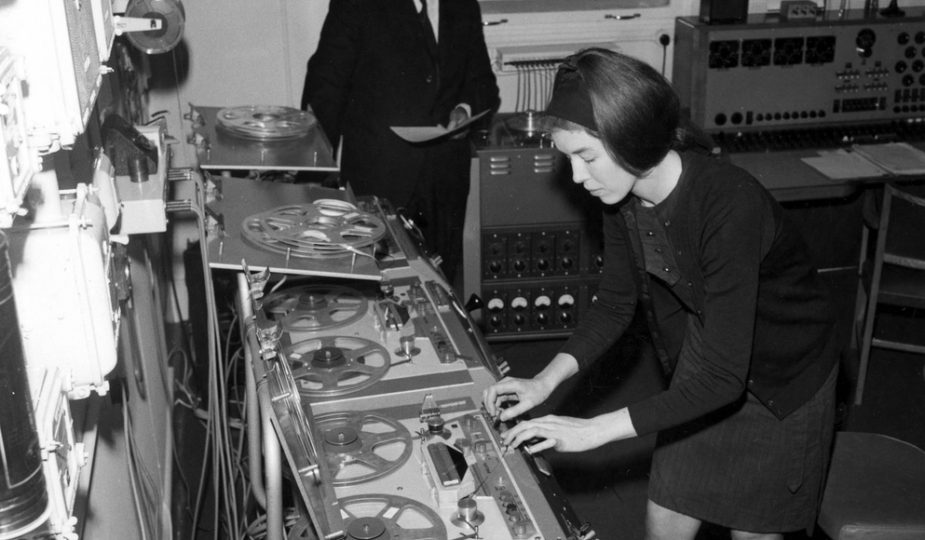
Delia Derbyshire’s Otherworldly, Spectral Soundscapes
Delia Derbyshire was born on May 5, 1937 in Coventry, England to working class parents Edward Derbyshire and Emma Dawson. As a child and adolescent, Delia was fascinated and obsessed with sound: the sounds of her father’s sheet metal factory, the sounds of the German blitz bombers as they flew over Coventry during World War II, the sounds of spring and summer in the Lancashire countryside where her grandparents and relatives lived. She studied medieval and modern music at Cambridge and graduated in 1959. She joined the BBC Radiophonic Workshop and trained there as an assistant.
At the age of 26 (in 1963) working class introvert Delia created what many consider to be the first electronic music track when she composed the opening theme for the science fiction television show Dr. Who. The hypnotic pulsar rhythms are like a bull’s hooves galloping through the farthest reaches of outer space while warped and weird warblings, extraterrestrials and UFOS, fly and swoop across the spinning spiral galaxies. Adrian Utley (of Portishead) called the Dr. Who theme “the single most important piece of electronic music.” What makes Delia Derbyshire’s score for Dr. Who and her later work so pioneering and revolutionary is the fact that it was entirely electronic and it was created only using filtering oscillators and magnetic tape splicing – before the Mellotron, Moog, and analog synthesizers even existed.
At the ages of 27-28 (1964-1965), Delia collaborated with poet Barry Bermange on an abstract and avant-garde series of Inventions for Radio (“Dreams”, “Amor Dei”, “Afterlife”, “Evenings”) where Bermange asked deep and profound questions within interviews of British citizens.
“The Dreams” is 42 minutes exploring dream imagery (“running”, “falling”, “land”, “sea”, “colour”) where Delia Derbyshire edited snippets of interviews to create a collage surrounded with somber, spooky, and strange sounds.
“Amor Dei” is 46 minutes exploring God (“Conceptions of God” and “A Capella Liturgica” are about how humans perceive God in different ways, while “I’d Like to Believe in God But…” and “There IS A God!” are about disbelief and faith in God, respectively.) Barry Bermange sketched an altarpiece in a Gothic architectural style and told Delia Derbyshire that he wanted “Amor Dei” to resemble a cathedral. Delia Derbyshire atmospherically captured his vision in her celestial and crystalline echoing effects. Delia Derbyshire’s “Amor Dei” is marvelously mystical and thought provoking.
At the ages of 29-30 (1967), Delia played in the countercultural Million Volt Light and Sound Rave at the Roundhouse Theatre and recorded what she later referred to as her favorite piece of music: “Blue Veils and Golden Sands.” She exclaimed “Doesn’t it just melt you!” “Blue Veils and Golden Sands” was recorded for a documentary about the nomadic Tuareg tribe in the Sahara desert. Delia shared in an interview that she tried to “convey the distance of the horizon and the heat haze and then there’s this very high, slow reedy sound. That indicates the strand of camels seen at a distance, wandering across the desert.” Delia said her most beautiful, ringing sounds were created on a a Coolicon green lampshade for this track. Delia used a small, soft hammer to hit the lampshade and, according to an interview with her, she “analyzed the sound into all of its partials and frequencies, and took the 12 strongest, and reconstructed the sound on the workshop’s famous 12 oscillators to give a whooshing sound. So the camels rode off into the sunset with my voice in their hooves and a green lampshade on their backs.” “Blue Veils and Golden Sands” is magical, moody, and mysterious.
At the age of 31 (1968), in Kaleidophon studios, Delia joined together with Brian Hodgson and David Vorhaus on electronics, Paul Lytton on percussion, and John Whitman, Annie Bird, and Val Shaw on vocals as the experimental collective White Noise to record their one and only album: Electric Storm. Although side one (“Phase-In”) is absurd and forgettable in its silly zaniness, the eighteen minutes on side two (“Phase-Out”) are truly unforgettable. The 11 minute “The Visitation” and 7 minute “Black Mass: An Electric Storm in Hell” are bizarre, disturbing, psychedelic, and sinister: a nightmarish bad trip.
At the ages of 35-36 (1973), Delia Derbyshire left behind the BBC Radiophonic Workshop where she had been employed for a decade and created one more recording with Brian Hodgson at Electrophon studios: the soundtrack for John Hough’s The Legend of Hell House (screenplay written by Richard Matheson based on his novel.) The Legend of Hell House is (alongside Tobe Hooper’s and Wayne Bell’s 1974 score for The Texas Chainsaw Massacre and Carl Zittrer’s 1974 score for Black Christmas) one of the eeriest horror movie soundtracks of all time. Although the soundtrack is rather short, the blood-curdling and bone-chilling background ghost voices Delia created in her electronic experimentation are sure to keep you shivering all through the night.
At the age of 37 (1974-1975), Delia had ended her career in electronic music. She passed away from alcoholism in the summer of 2001. Delia Derbyshire influenced and inspired so many later artists and musicians: Broadcast and Trish Keenan, the library music genre, and the entire Hauntology collection of albums on the Ghost Box Records label. Delia’s otherworldly, spectral soundscapes will continue to be mindbending and spellbinding for future generations.
by Mark Lager

What an artist, her influence is still relevant. She is respected by the most introspective sides of electronic music (Aphex Twin, Orbital, etc). Amazing article!
Agreed Octavio. Delia was an innovator.
Really knew very, very little about Delia Derbyshire. Although I have seen the name mentioned exploring the more experimential corridors of music. But now I have know choice, I must jump in further. Anytime a recording takes 46 minutes tp explore the theme of God…Well, I need to hear more. Great article, Mark.
Cheers Shawn.
One of the forgotten pioneers of electronic music.
Agreed Günther. Delia Derbyshire was incredibly innovative.
Brian Eno loves her.
Derbyshire and Eno = ambient geniuses.
Fantastic read! But Delia Derbyshire didn’t actually compose the Dr. Who score, that was Rob Grainer. She arranged it or did a version of it. “When I saw Ron Grainer’s score,” said Derbyshire, “there were some swoops indicated, and I assumed those were sine-waves. I think he may have described this as guitar plus something like a bassoon or something. He also used words like clouds and wind bubbles. Clouds, obviously one thinks of as filtered white noise, and wind bubble, I think we used the wobbulator.”
I wasn’t aware of Derbyshire until I got her Dreams album as gift a couple of years ago. It’s in the “very special” section of my record collection. After reading your article I discovered that she later worked with Peter Kember – what a duo… Thanks for this great special
Saliha,
Delia Derbyshire’s electronic experiments are mesmerizing. Dreams is mindbending and mysterious. Thank You for sharing my essay.
[…] Long Year” returns us to the infinite void with a cinematic instrumental containing echoes of Delia Derbyshire and the United States of America. The midnight train leaves the city in progress for a new […]
It is not my first time to go to see this web site, i am browsing this site dailly and obtain fastidious information from here.
She was certainly one of a kind and, as you say, hugely influential. Had no idea that she passed away due to the effects of alcohol. Very sad, but at least we have the legacy of her musical explorations to listen to forever.
Cheers R.